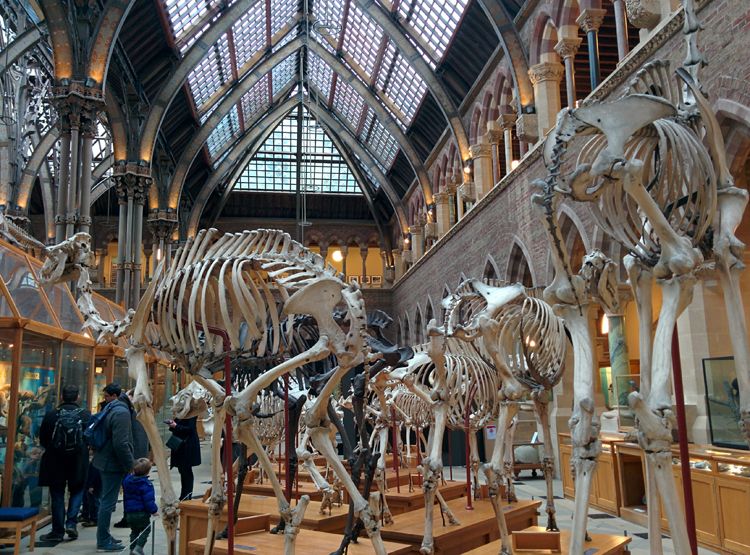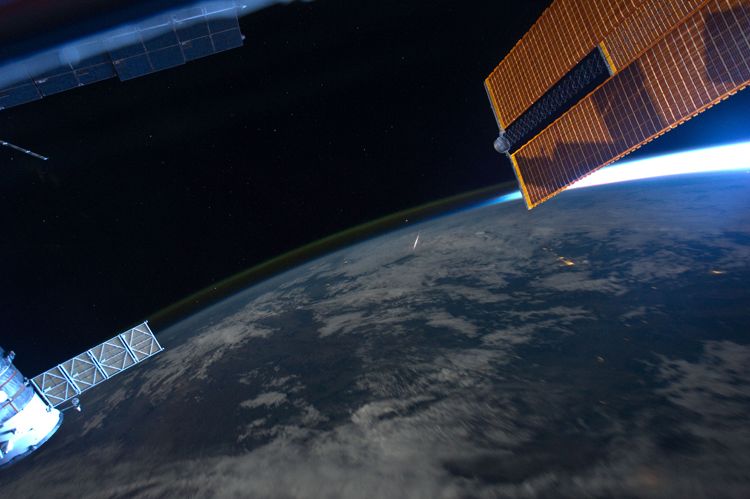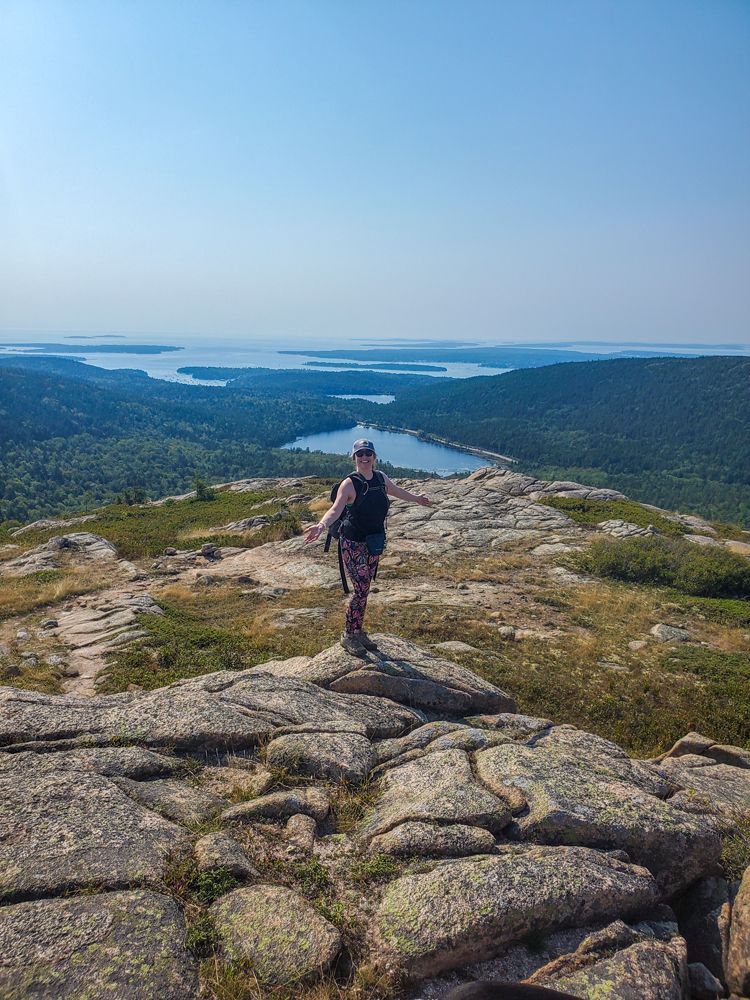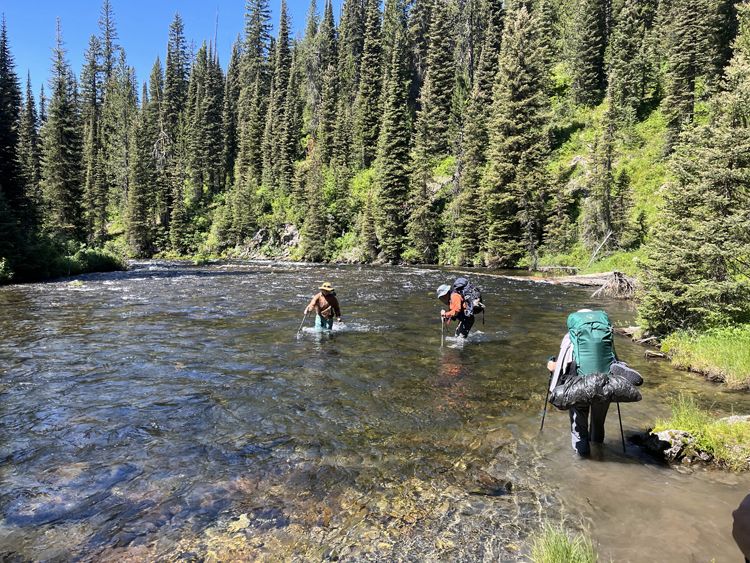Early Career Scientist Spotlight
Dr. Erin Dawkins (she/her/hers)
Atmospheric Scientist
Ionosphere, Thermosphere, Mesosphere Physics Laboratory (675)
What inspired you to pursue a career in atmospheric science?
My route to atmospheric science has certainly not been linear, but instead I think it reflects a natural development and progression of interests over time. From as early as I can remember, I have loved spending time outside and have always been fascinated by the natural world around us. Like many British kids, I grew up watching BBC natural history and wildlife programs on TV presented by the legendary British broadcaster, naturalist and author, Sir David Attenborough. He also authored one of my favorite books, “Life on Earth”, in which he describes how early environmental conditions helped shape the development and evolution of animal and plant life. I went on to study Zoology at the University of Sheffield and through my dissertation research became increasingly fascinated with how the Earth’s physical changes could at times promote the proliferation and development of some species, and at other times be so destructive and result in mass extinction events.
At the time of my graduation, the fourth Intergovernmental Panel on Climate Change (IPCC) report had not long been released, and this detailed the physical changes that were occurring, specifically warming, and how these were very likely attributable to anthropogenic emissions of greenhouse gasses. From my undergraduate Master’s research, I knew how sensitive the climate system was and I wanted to meaningfully contribute to research focused on present day climatology.
I applied for and was accepted onto the University of Birmingham Master of Applied Meteorology and Climatology (MSc) course; something that I am forever grateful for as - at the time - my zoology/biology background certainly was not on the list of course prerequisites, and I think someone took a chance on me based on my cover letter explaining my motivation for applying. Despite it being a very steep learning curve, I loved gaining a better understanding of the physics of the atmosphere. For my Master’s thesis, I worked with Dr. Chris Kidd (now at NASA Goddard also!) using data from the NASA Tropical Rainfall Measurement Mission (TRMM). Whereas I had previously spent hours upon hours staring down a microscope at microfossils, being able to use data from operational spacecraft flying high up in the sky above really captivated me. After graduating, I spent time volunteering at the UK’s Royal Meteorological Society as well as completing a Visiting Scientist placement at the Rutherford Appleton Laboratory (UK) where I was able to gain experience with data from European Space Agency (ESA) satellite missions, in addition to further developing my computer programming skills.
For my PhD, I had the opportunity to work with Profs. John Plane and Martyn Chipperfield at the University of Leeds using satellite data from the OSIRIS (Optical Spectrograph and Infrared Imager System) instrument onboard the Swedish-led Odin spacecraft. My PhD work focused on converting light scattered from atoms that are released as meteoroids burn up (a.k.a. shooting stars), in order to produce new datasets which can be used to examine the chemistry and dynamics occurring at the boundary where our atmosphere meets the edge of space. I once again experienced another steep learning curve (this time in chemistry), and I remain incredibly grateful to both of my advisors for their support, guidance, and mentorship over the course of my PhD. As part of this work, I had the opportunity to meet and collaborate with international partners, one of which being my current excellent mentor, Dr. Diego Janches. He offered a postdoctoral position to work with him at NASA Goddard continuing much of the work I had completed for my PhD, and I’ve been here ever since working as an atmospheric scientist.

Credit: Erin Dawkins
What science questions do you investigate?
The majority of my research while at NASA has been related to my PhD and has focused on the study of meteoroids and what they can tell us about our Earth’s atmosphere, the near-space environment, as well as the lunar environment. Meteoroids are meteoric particles that are small and fast enough to burn up entirely within the Earth’s upper atmosphere known as the mesosphere/lower thermosphere region (“MLT”, between 70-120 km altitude). In doing so, they vaporize and inject all their constituent metal atoms and ions into this region, and these are detectable by ground- and space-based instruments. We can then track the concentration and movement of these particles at various spatial and temporal scales and use them as incredibly helpful “tracers” for atmospheric chemistry and dynamics in a part of the Earth’s atmosphere that is otherwise quite difficult to observe.
During my time at NASA, I have had the opportunity to use data from the SABER (Sounding of the Atmosphere using Broadband Emission Radiometry) instrument onboard the NASA TIMED (Thermosphere, Ionosphere, Mesosphere Energetics and Dynamics) mission, as well as from ground-based metal and temperature lidars. We can also study the lunar environment by detecting some of these meteoric metals, and I have been working with Dr. Menelaos Sarantos using data from the UVS (Ultraviolet Visible Spectrometer) instrument onboard the now decommissioned NASA LADEE (Lunar Atmosphere and Dust Environment Explorer) spacecraft to detect the spatial and temporal variation of sodium in the lunar atmosphere.
More recently, I have had the opportunity to work with ground-based meteor radar datasets, as well as continuing to benefit from the expertise of Dr. Diego Janches to learn more about the physics of meteor radars. A recent paper of ours utilizes new polarization measurements and orbital information from a single meteor detection and combines these with two state-of-the-art chemistry and physics models to allow us to determine the velocity and mass of this detected meteoric particle prior to it decelerating and losing mass during atmospheric entry. The next step will be to automate this methodology to allow for rapid and near real-time processing of individual detected particles, in order to provide more precise meteor orbits and characterization of parent source populations, to possibly enable the detection of potential interstellar objects, as well as to help further constrain the total amount of cosmic dust entering the Earth’s atmosphere every year.

Credit: NASA/Ron Garan
What is one thing you wish everyone knew about your particular field of science?
Compared to other layers of the Earth’s atmosphere, far fewer measurements exist of the MLT region, and yet it is an incredibly important boundary between the atmosphere below and space above. It’s a place of beauty; it is here we get wispy polar mesospheric clouds (the highest clouds in our atmosphere), it is where the air is just dense enough that incoming meteoroids burn up and produce bright streaks of light, and it is also home to magically named electrical phenomena known as sprites, halos, and elves, just to name a few!
Unfortunately, we are already seeing the effect of anthropogenic greenhouse gasses emitted at the Earth’s surface impacting the top of our atmosphere. In contrast to their warming effect at the surface, these same greenhouse gasses (which get transported upwards), act as infrared “coolers” at higher altitudes. This is because the air is so thin here that any heat energy emitted from these molecules is simply lost to space (rather than being reabsorbed by adjacent molecules). Decades of temperature measurements have shown that the upper atmosphere is cooling, and that the magnitude of this cooling is considerably larger than the rate of heating at the Earth’s surface. Polar mesospheric clouds are thought to be sensitive indicators of climate change since they form only under very specific conditions (very cold temperatures and with enough water vapor present). The frequency and range of these clouds has increased such that they have now been observed at mid-latitudes, far beyond their previous polar range, providing additional evidence that our upper atmosphere is changing.
Recent work performed by myself and colleagues studied the mean altitudes at which meteoroids burned up and became detectable by meteor radars, and provides further support of a changing atmosphere. We examined long-term datasets from 12 different meteor radar stations, located at a broad range of latitudes, and found that the mean altitude at which meteoroids are burning up has been decreasing over time. These findings are consistent with the contracting or shrinking of the upper atmosphere due to cooling which results in incoming meteoroids reaching increasingly lower altitudes before they burn up.
Although we know that all parts of the atmosphere are coupled and interconnected, we do not yet fully understand this delicate balance. It is currently unclear how the cooling and shrinking of the upper atmosphere, in response to increasing greenhouse gas emission from the Earth’s surface, will in turn influence and impact the lower atmosphere. Thus, it is imperative that we continue to obtain measurements, monitor, and increase our understanding of this important, but historically overlooked, region of the atmosphere.

Credit: Erin Dawkins
What was your first big research achievement?
My first big research achievement was my meteorology Master’s thesis which formed the basis for a paper that was published in a scientific journal. The work focused on evaluating the performance of the European Center for Medium-range Weather Forecasting (ECMWF) operational forecasting model with satellite data from the NASA TRMM satellite to assess how well the model was able to simulate the mean annual and seasonal diurnal rainfall cycles. My Master’s year was challenging as I switched from zoology to atmospheric physics, but having this work published represented a rewarding milestone I am extremely proud of.

Credit: Erin Dawkins
What do you enjoy the most about your job?
Aside from the privilege of being able to work alongside such incredibly inspiring and supportive colleagues and collaborators using data from NASA missions, one of the things I enjoy most is how creative research can be. While you often have scientific theories that can be tested and applied, other times research is much more exploratory, and you must use a lot of lateral thinking in order to make new discoveries. Another key part of my job that I love is writing code and finding creative solutions to the handling and processing of large real-world datasets, applying familiar and sometimes new processing techniques, to test, rule out, or discover and uncover exciting new information and results from the data.

Credit: Kristina Brown
What advice would you give your younger self?
As someone who struggles with perfectionism, I would definitely encourage my younger self to be okay with, and work on becoming increasingly comfortable with the idea of “failing forward”, that is trying, failing, trying again, and all the while making progress. Putting in the effort, not being afraid to try and risk temporary failure, to learn and pivot, and to try again is an absolute strength for any person to attain or possess. Often you only realize how much progress you have made in retrospect, but I think learning to become comfortable with being uncomfortable and out of your element is how personal progress and growth is achieved. Anticipating and embracing this only makes progress all the quicker. Another piece of advice I would give my younger self is to remain open minded and take advantage of opportunities to learn, either from others or from experiences. To always have a plan and direction, but to retain a flexibility to deviate, explore and modify accordingly. I am incredibly grateful to each of my mentors over the years who have kindly shared their insight and guidance with me. I would certainly encourage others to seek out mentorship opportunities in any form that they may present themselves, whatever stage you may be in your career. Equally, I think it is so important to reciprocate and to provide mentorship to others. In both cases, I think the sharing and receiving of perspectives from people different to you, and with different life experiences, is invaluable and may offer perspectives and insight that you otherwise may not be aware of.

Credit: Sheldon Alberts
What do you like to do in your free time?
I like to spend most of my free time outside hiking with my dog, trail running, and more recently orienteering (combining walking/running with navigation to different checkpoints). I love to learn new skills and really enjoy the self-sufficiency aspect of backcountry hiking and camping; this year I completed a Wilderness First Aid course, and I am currently working towards completing a more in-depth Wilderness First Responder course. Other current hobbies include playing ice hockey, traveling with my husband, spending time with my dog and horse, fostering dogs (and trying hard not to adopt every single one!), baking and drawing (and anything crafty/creative), practicing the piano, and learning the ukulele.
Biography
Home Town:
Oxford, United Kingdom
Undergraduate Degree:
MBiolSci Zoology, University of Sheffield, UK
Post-graduate Degrees:
MSc Applied Meteorology and Climatology, University of Birmingham, UK
PhD Atmospheric Physics, University of Leeds, UK

Link to Dr. Dawkins's GSFC Bio
